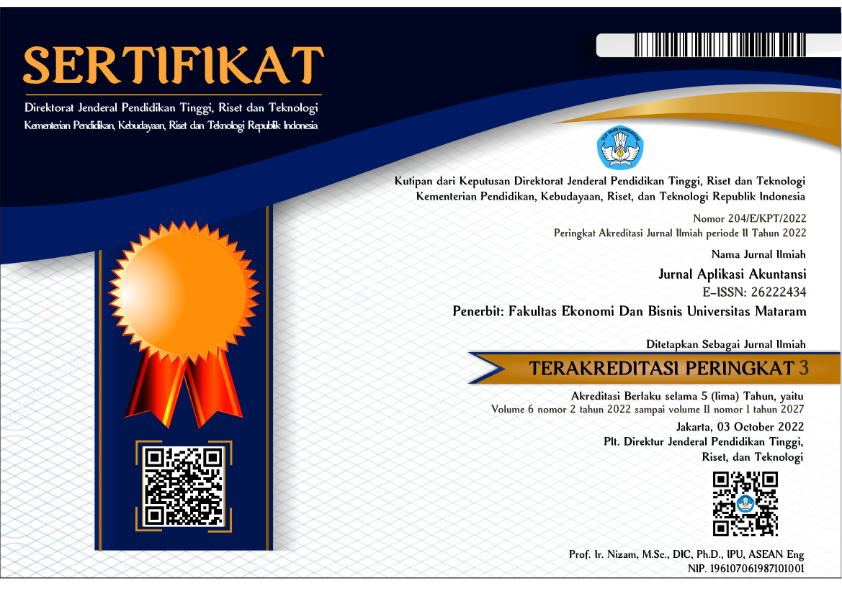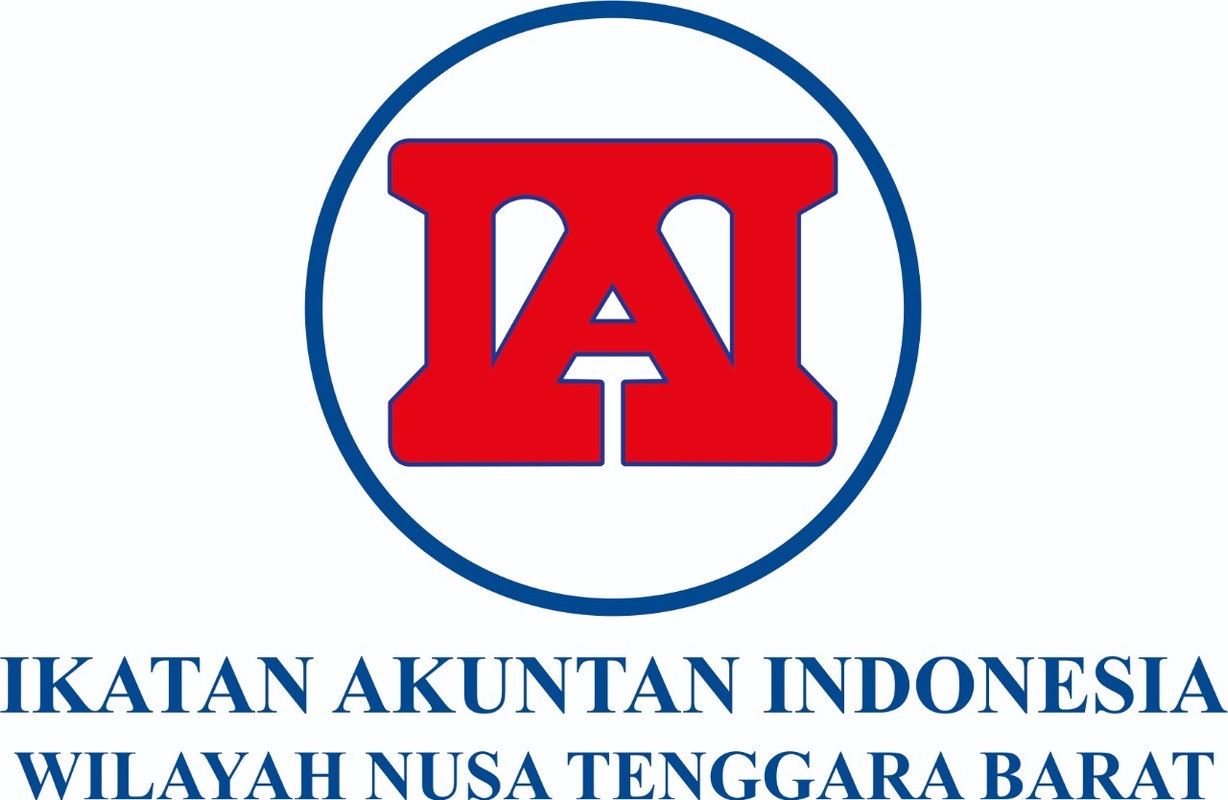RESILIENSI PERBANKAN INDONESIA SELAMA PANDEMI COVID-19: SUATU EVALUASI MULTIDIMENSIONAL BERBASIS MCDM
DOI:
https://doi.org/10.29303/jaa.v7i2.212Keywords:
Covid-19, MCDM, Resilience, TOPSIS Method, ResiliensiAbstract
Abstract: This study aims to analyze the resilience level of a banking group sample in Indonesia during the Covid-19 pandemic classified by core capital-3 (KBMI 3) through the application of the TOPSIS method as an MCDM-based multidimensional evaluation by considering a number of weighting factors. The results of this study are the scores and rankings of each bank which are categorized into three groups namely top resilient, middle resilient, and low resilient. BTPN and MEGA are the most resilient banks while BBTN is the least resilient bank in dealing with the negative impact of the Covid-19 pandemic in our sample. This study concludes that banks with low capital adequacy ratios, low liquidity ratios, low profitability ratios, and low credit quality levels are the most vulnerable to shocks during the Covid-19 pandemic. Therefore, bank management is expected to strengthen its capital adequacy ratio, and improve the effectiveness of credit management to reduce the number of non-performing loans and mitigate risks through the application of prudential principles in distributing loans and not relying on income from credit interest only.
Abstrak: Penelitian ini bertujuan menganalisa tingkat resiliensi satu sampel kelompok bank di Indonesia selama pandemi Covid-19 yang diklasifikasikan berdasarkan nilai kepemilikan modal inti 3 (KBMI 3) melalui penerapan metode TOPSIS sebagai suatu evaluasi multidimensional berbasis MCDM dengan mempertimbangkan sejumlah faktor pembobotan. Hasil penelitian ini berupa nilai dan peringkat setiap bank yang terbagi ke dalam tiga kategori resiliensi yaitu top resilient, middle resilient, dan low resilient. BTPN dan MEGA di dalam sampel penelitian ini merupakan bank-bank yang paling tinggi resiliensinya sedangkan BBTN merupakan bank yang paling rendah resiliensinya dalam menghadapi dampak negatif pandemi Covid-19. Penelitian ini menyimpulkan bahwa bank-bank yang memiliki rasio kecukupan modal, rasio likuiditas, rasio profitabilitas dan tingkat kualitas kredit yang rendah merupakan bank yang paling rentan terhadap guncangan selama pandemi Covid-19. Oleh karena itu, manajemen perbankan diharapkan dapat memperkuat rasio kecukupan modal yang dimiliki, meningkatkan efektivitas pengelolaan kredit untuk mengurangi jumlah kredit bermasalah dan melakukan mitigasi risiko melalui penerapan prinsip kehati-hatian dalam mendistribusikan kredit serta tidak menggantungkan pendapatan hanya dari bunga kredit.
References
Abdel-Baki, M. A. (2012). The impact of Basel III on emerging economies. Global Economy Journal, 12(2), 1850256.
Apergis, N. (2022). Convergence in non-performing loans across EU banks: The role of COVID-19. Cogent Economics & Finance, 10(1), 2024952.
Ari, A., Chen, S., & Ratnovski, L. (2021). The dynamics of non-performing loans during banking crises: A new database with post-COVID-19 implications. Journal of Banking & Finance, 133, 106140.
Athanasoglou, P. P., Brissimis, S. N., & Delis, M. D. (2008). Bank-specific, industry-specific and macroeconomic determinants of bank profitability. Journal of International Financial Markets, Institutions and Money, 18(2), 121–136.
Barua, B., & Barua, S. (2021). COVID-19 implications for banks: evidence from an emerging economy. SN Business & Economics, 1(1), 1–28.
BCBS. (2009). Consultative Document - Strengthening the Resilience of the Banking Sector. In Basel Committee on Banking Supervision. Retrieved from https://www.bis.org/publ/bcbs164.pdf
BCBS. (2010). Basel III: A global regulatory framework for more resilient banks and banking systems. Retrieved from https://www.bis.org/publ/bcbs189_dec2010.pdf
Beck, T., & Keil, J. (2021). Are banks catching corona? Effects of COVID on lending in the US. CEPR Discussion Paper No. DP15869, Available at SSRN: https://ssrn.com/abstract=3805284.
Berger, A. N., & Bouwman, C. H. S. (2009). Bank liquidity creation. Review of Financial Studies. https://doi.org/10.1093/rfs/hhn104
Chakroun, F., & Abid, F. (2016). Capital adequacy and risk management in banking industry. Applied Stochastic Models in Business and Industry, 32(1), 113–132.
Demirgüç-Kunt, A., Pedraza, A., & Ruiz-Ortega, C. (2021). Banking sector performance during the COVID-19 crisis. Journal of Banking & Finance, 133, 106305.
Dey, B. K. (2019). Managing nonperforming loans in Bangladesh. ADB Brief No. 116 November 2019. Publisher Asian Development Bank. DOI: http://dx.doi.org/10.22617/BRF190507-2.
Disemadi, H. S., & Shaleh, A. I. (2020). Banking credit restructuring policy amid COVID-19 pandemic in Indonesia. Jurnal Inovasi Ekonomi, 5(02).
Effendi, I., & RS, P. H. (2020). Dampak Covid 19 Terhadap Bank Syariah. Ekonomikawan: Jurnal Ilmu Ekonomi Dan Studi Pembangunan, 20(2), 221–230.
Elekdag, S., Malik, S., & Mitra, S. (2020). Breaking the bank? A probabilistic assessment of Euro area bank profitability. Journal of Banking & Finance, 120, 105949.
Gelzinis, G. (2020). Bank Capital and the Coronavirus Crisis: 4 Ways the Federal Reserve Can Improve the Resilience of the Banking System. Publisher World Health Organization.
Ghosh, R., & Saima, F. N. (2021). Resilience of commercial banks of Bangladesh to the shocks caused by COVID-19 pandemic: an application of MCDM-based approaches. Asian Journal of Accounting Research.
Goodell, J. W. (2020). COVID-19 and finance: Agendas for future research. Finance Research Letters, 35, 101512.
Gudmundsson, R., Ngoka-Kisinguh, K., & Odongo, M. (2013). The role of capital requirements on bank competition and stability: The case of the Kenyan banking industry. KBA Centre for Research on Financial Markets and Policy Working Paper Series.
Hanafi, R., Rohman, A., & Sutapa, S. (2022). Islamic Bank Resilience: Financial and Sharia Performance During Covid-19 Pandemic in Indonesia. Muqtasid: Jurnal Ekonomi Dan Perbankan Syariah, 13(1), 18–30.
Hossain, M. Z., Khan, M. A. R., & Sadique, M. S. (2018). Basel III and perceived resilience of banks in the BRICS economies. Applied Economics, 50(19), 2133–2146.
Karugu, C., Achoki, G., & Kiriri, P. (2018). Capital adequacy ratios as predictors of financial distress in Kenyan commercial banks. Journal of Financial Risk Management, 7(03), 278.
Kemnaker. (2020). Survei Kemnaker : 88 Persen Perusahaan Terdampak Pandemi Covid-19. Retrieved June 4, 2022, from Biro Humas Kemnaker website: https://kemnaker.go.id/news/detail/survei-kemnaker-88-persen-perusahaan-terdampak-pandemi-covid-19
Korzeb, Z., & Niedziółka, P. (2020). Resistance of commercial banks to the crisis caused by the COVID-19 pandemic: the case of Poland. Equilibrium. Quarterly Journal of Economics and Economic Policy, 15(2), 205–234.
Kozak, S. (2021). The Impact of COVID-19 on Bank Equity and Performance: The Case of Central Eastern South European Countries. Sustainability, 13(19), 11036.
Laeven, L., & Levine, R. (2009). Bank governance, regulation and risk taking. Journal of Financial Economics, 93(2), 259–275.
Liputan6.com. (2021). Kemnaker: 72.983 Pekerja Kena PHK Selama Pandemi Covid-19. Retrieved March 10, 2022, from Liputan6 website: https://www.liputan6.com/bisnis/read/4750566/kemnaker-72983-pekerja-kena-phk-selama-pandemi-covid-19
Martynova, N. (2015). Effect of bank capital requirements on economic growth: a survey. De Nederlandsche Bank Working-paper No. 467.
Maulana, M. I. (2021). Ketidakseimbangan Penawaran dan Permintaan Kredit di Indonesia Selama Periode Pandemi Covid-19. Bank Indonesia, 1–16. Retrieved from https://www.bi.go.id/id/publikasi/ruang-media/news-release/Documents/Juara_1_-_LKISSK_2021_-_Mohamad_Indra_Maulana.pdf
Maulida, Z., Ibnu, A. R., & Khair, M. (2022). Analisis Perbandingan Ketahanan (Resilience) Keuangan Bank Umum Syariah antara Sebelum dan Selama Pandemi Covid-19. Istithmar: Jurnal Studi Ekonomi Syariah, 6(1), 59–67.
Nizar, N. I., Putranto, I., & Nasution, A. Y. (2022). Testing The Resilience of Sharia Bank During Covid-19 Pandemic. Jurnal Mandiri: Ilmu Pengetahuan, Seni, Dan Teknologi, 6(1), 31–46.
Nufus, E. H., Zuhroh, I., & Suliswanto, M. S. W. (2021). Analysis of COVID-19 impact on micro, small, and medium enterprises (MSMEs) credit distribution in East Java Banks. Journal of Accounting and Invesment, 22(2), 343–360.
Nurafini, F. (2022). Studi Perbandingan Tingkat Kesehatan Bank Antara Bank Syariah dan Bank Konvensional di Indonesia Selama Pandemi Covid-19. Jurnal Ilmiah Ekonomi Islam, 8(3), 2690–2699.
OJK. (2021). Statistik Perbankan Indonesia-Juni 2021. Retrieved from https://www.ojk.go.id/id/kanal/perbankan/data-dan-statistik/statistik-perbankan-indonesia/Documents/Pages/Statistik-Perbankan-Indonesia---Juni-2021/SPI Juni 2021.pdf
Paul, T. C. (2021). Covid-19 Impact in Banking Industry. Retrieved from https://mblbd.com/assets/corporate/senior/COVID-19-Impact-in-Banking-Industry.pdf
Perdana, D. (2022). Likuiditas, Profitabilitas dan Kecukupan Modal Bank Di Indonesia. Wahana: Jurnal Ekonomi, Manajemen Dan Akuntansi, 25(2), 135–149.
Perdana, D., & Kusumadewi, H. (2021). Tingkat Solvabilitas Perbankan Indonesia Dalam Konteks Pemenuhan Ketahanan Likuiditas. Jurnal Riset Akuntansi Dan Keuangan, 9(1), 193–208.
Pratama, A. A. P. (2019). Capital and lending growth of banking sector in Indonesia: Study on the BUKU category. Jurnal Keuangan Dan Perbankan, 23(4), 489–502.
Reeves, M., & Whitaker, K. (2020). A guide to building a more resilient business. Harvard Business Review, 2–8.
Rini, A. S. (2021). Selama Pandemi Perbankan Tutup Lebih dari 1.200 kantor. Retrieved April 3, 2022, from Bisnis.com website: https://finansial.bisnis.com/read/20210910/90/1440759/selama-pandemi-perbankan-tutup-lebih-dari-1200-kantor
Surahman, S., Kamal, I., Rosari, R., Susilowati, E., & Cakranegara, P. A. (2022). The Impact of the Covid-19 Pandemic on Banking Risks and Performance. Budapest International Research and Critics Institute (BIRCI-Journal): Humanities and Social Sciences, 5(1), 3248–3254.
Suryadi, B., & Djuniar, L. (2017). Pengaruh Rasio Capital Adequacy, Loan to Deposit, Net Interest Margin Terhadap Pertumbuhanlaba (Studi Kasus Pada Bank Umum Konvensionalyang Terdaftar Di Bursa Efek Indonesia). Akuntabilitas, 11(2), 115–126.
Taswan. (2010). Akuntansi Perbankan, Transaksi Dalam Valuta Rupiah (III cetaka). Yogyakarta: UPP STIM YKPN.
Tsai, J.-Y., & Chen, S. (2015). How does equity capital cost affect bank performance during a financial crisis? Applied Economics, 47(42), 4459–4474.
Van Greuning, H., & Bratanovic, S.-S. B. (2020). Capital Adequacy. World Bank Group. https://doi.org/10.1596/978-1-4648-1446-4_ch6.
Vazquez, F., & Federico, P. (2015). Bank funding structures and risk: Evidence from the global financial crisis. Journal of Banking & Finance, 61, 1–14.
World-Bank. (2020). Global Financial Development Report 2019 / 2020: Bank Regulation and Supervision a Decade after the Global Financial Crisis. https://doi.org/10.1596/978-1-4648-1447-1
Yusgiantoro, I., Wirdiyanti, R., & Malinda, M. (2019). Bank Capital, Liquidity Creation, Profitability, and Financial Stability: Evidence Across Countries. Otoritas Jasa Keuangan Working Paper.
Downloads
Published
How to Cite
Issue
Section
License
Copyright (c) 2023 Djaja Perdana

This work is licensed under a Creative Commons Attribution-NonCommercial-ShareAlike 4.0 International License.









